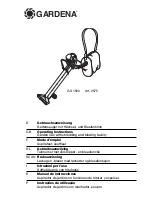
In order to operate safely in approved hazardous locations, the
vacuum must be properly grounded during operation. Proper
grounding can be achieved in one of three ways:
Option One
is through use of the static conductive air supply
hose. This option utilizes a static conductive air supply hose to con-
nect the vacuum to a compressed air distribution system that is in
turn grounded. Only use this method if the compressed air distribu-
tion system has been verified to be electrically grounded.
Option Two
is through use of the grounding lug. This option
utilizes a direct electrical connection from the grounding lug on the
vacuum cover to a verified electrical ground (i.e. electrical cabinet,
ground rod, water pipe, etc.). The connection from the grounding
lug to electrical ground can be achieved via wire, cable, or a
ground strap with clamps.
Option Three
is to operate the vacuum on an electrically grounded
surface. This option provides conductivity from the vacuum directly
to an electrically grounded surface (i.e. steel plate, concrete
ground level floor, etc.). The container of the vacuum can rest on
the grounded surface directly, or on the dolly. Both the container
and the dolly, including wheels, are constructed from conductive
material (steel). Only use this method if the surface is electrically
grounded, and only when a continuous electrical connection be-
tween the vacuum and the surface can be maintained.
GROUNDING THE VACUUM
SET-UP AND OPERATION
Make sure the ball valve on the vacuum is turned off.
Turn on the compressed air supply and open the ball valve on the
vacuum to operate the unit.
Connect the vacuum hose and desired accessories to the vacuum.
Connect the air supply hose to the vacuum using Chicago style
connectors and install the safety clips.
NOTE:
Take time to understand the specific nature of
the material to be vacuumed and take all necessary
precautions specific to that material. For example,
allow proper charge relaxation time prior to remov-
ing the vacuum lid.
Prior to operating the vacuum, inspect the unit and replace worn
or broken components. Use only original NORTECH equipment as
replacement parts.
Inspect the bottom side of the vacuum head cover to ensure the
filter and/or liquid shut-off valve is securely in place by use of the 3
supplied springs. The springs secure the filter in place, and electri-
cally connect the filter to the vacuum.
Place the vacuum head on the drum and clamp the lid to the con-
tainer. Ensure the cover clamps are locked in place.
NOTE:
Employing multiple, redundant grounding
options is always good operating practice.
FOR ALL GROUNDING OPTIONS, IT IS RESPONSIBIL-
ITY OF THE END-USER TO ENSURE PROPER CONNEC-
TION TO, AND THE ELECTRICAL INTEGRITY OF, THE
GROUND.
Make sure the vacuum has been grounded via one or more of the
options described in
GROUNDING THE VACUUM
on Page 4.
4
5


























